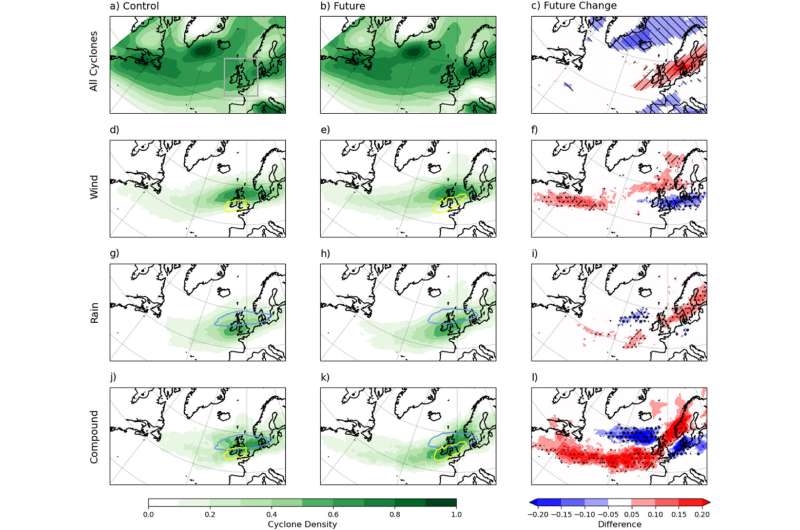This article has been reviewed according to Science X's editorial process and policies. Editors have highlighted the following attributes while ensuring the content's credibility:
fact-checked
trusted source
proofread
New research investigates how climate change amplifies severity of combined wind-rain extremes over the UK and Ireland

Climate change will cause an increase in extreme winter storms combining strong winds and heavy rainfall over the UK and Ireland, new research has shown.
The new study was led by experts at Newcastle University and the Met Office and investigated how future climate change may influence compound wind-rain extremes, which are events where extreme wind and rainfall occur simultaneously.
The researchers analyzed data from climate simulations covering control (1981–2000) and future (2060–2081) periods, to assess potential changes in these extreme events. Their findings show that, as the climate warms, these events are likely to become more severe, with stronger winds and heavier rainfall happening together.
These changes are mainly driven by increased rainfall, a thermodynamic response to rising temperatures. Additional contributing factors include a strengthened jet stream and its southward displacement that brings storms through warmer areas leading to further increases in rainfall.
Publishing their findings in the journal Weather and Climate Extremes, the scientists show that the increase in intensity could lead to more frequent windstorms coinciding with extreme rainfall and floods, posing challenges to coastal areas susceptible to compound flooding as well as emergency response resources due to larger aggregation of separate impacts to infrastructure such as electricity networks and rail transport networks.
Study lead author, Dr. Colin Manning, Research Associate at Newcastle University's School of Engineering and Visiting Scientist, Met Office, Hadley Centre, said, "Our work shows that such compound extremes will occur more frequently as our climate warms and likely bring more severe impacts, and a higher aggregation of separate damages arising from wind and flooding which may stretch emergency response resources.
"Avoiding the worst of these impacts will require cutting our greenhouse gas emissions and increasing the resilience of our infrastructure."
The team used a number of methods to analyze compound wind-rain extremes and their future changes. They used an event-based analysis based on the occurrence of an extra-tropical cyclone (ETC) over the UK and Ireland. By linking extreme wind and rainfall events to these systems, the scientists assessed their severity using Wind Severity Index (WSI) and Rainfall Severity Index (RSI).
Return periods (RPs) were estimated for both individual and joint extremes, indicating their likelihood, while the team categorized events based on their wind and rainfall characteristics. In addition, the researchers identified local co-occurrences of extreme wind gusts and rainfall to understand their changing intensity contributions in future simulations.
Professor Lizzie Kendon, Head of Understanding Climate Change at the Met Office and co-author on the paper, said, "This work exploits the latest high resolution climate projections for the UK, UKCP Local, where the Met Office weather forecast model has been run to give 100-y long climate projections at km-scale. These are providing new insights into how the UK climate may change at the very local scale, and how changes in weather extremes may be realized over the coming years and decades.
"This is highlighting the importance of considering compounding effects, including co-occurrences of different hazards, as well as the clustering of extreme events, in fully capturing the potential impacts of climate change."
This research sets the stage for further investigation into the mechanisms driving compound wind-rain extremes. Future research will need to consider a greater range of climate models to understand if the results are robust across different models.
Research is also required to understand and quantify the link between these compound extremes and the resultant impacts which would help stakeholders better understand their risk and choose the most cost-effective adaptations to reduce risks.
More information: Colin Manning et al, Compound wind and rainfall extremes: Drivers and future changes over the UK and Ireland, Weather and Climate Extremes (2024). DOI: 10.1016/j.wace.2024.100673
Provided by Newcastle University





















